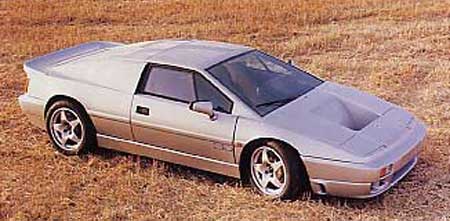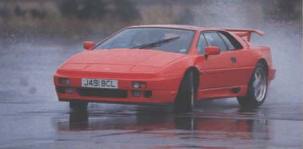

Flat out in Lotus's
supercar saviour
Meet SID, another technological
tour de force from Lotus - and the clearest idea yet of what the new Esprit
supercar will be like.
If they told us once, they told us half a dozen times: SID is not the Esprit. It doesn't look like the new Esprit - that much is obvious- and its 300bhp turbocharged V6, four-wheel drive, four-wheel steering, active ride and monocoque construction aren't a blue print for the much needed supercar successor either. SID is a research vehicle, and research vehicles come a long way before prototypes - at least in practice. In theory less so, especially when managing director Adrian Palmer has said the new Esprit, when it comes in 1995, will marry Lotus technology to a Lotus badge for a car that "will go straight to the top of next century's supercar league."
No, this is not the new Esprit but SID is one hell of a lot closer to it than anything else. It is also a lot closer than anything else I have driven to indeed being the mind blowing paragon Palmer says it will be. It's raining, and has been all morning. Lotus's notoriously rough handling tracks, potholed and broken-edged, is awash, more like an access road to a quarry than a test track. There's one corner up the top with a late apex and a wide, wide exit where playing with 300bhp is feasible; messy, perhaps, but safe. On this wet day it's not difficult to think of several 300bhp cars that would soon face the way they had come given imprudence on the loud pedal.
Throwing SID into this corner in these conditions seemed as ambitious as pitching a go-kart into a rallycross bend. Seven hundred and fifty Lotus Engineering brains, God knows how many RAM of intelligent computer-aided design memory and the multi-talented bottoms, hands and feet of test drivers Roger Becker and John Miles said it was going to be all right. It was. SID sailed through under full power, absolutely flat of body and understeering gently. There was nothing the driver had to do but sit tight. There was no loss of traction, no body roll and, best of all perhaps, such a feeling of isolation from the water-filled potholes outside they may as well not have been there.
On the lumpy and patched back straight at 90mph, a tough ride test for a luxury saloon, SID obliterated the contours at the expense of neither harshness not float. And on the staright at 60mph, a violent right-left-right flick to simulate an emergency lane change gave a g-force range of plus 1g to minus 1g, all within about half a second. Same streaming wet surface, but still the same ferocious turn-in, grip and neutrality.
God, what feats have been performed on that lumpy old airfield in the name of progress, Lotus-style. For years now a journalist visiting Hethel and allowed to play with the really trick developments has inevitably come away not just impressed but with a whole new set of reference points. Whatever you may think of its manufacturing stuff-ups, when Lotus engineers push the outside of the envelope, finding solutions to questions other companies haven't even started asking, they really push it.
So why is this research vehicle so special? For starters it is not just an active suspension car, nor is it just a four-wheel steering, fout-wheel drive or monocoque test rig. It is rather a rolling test bed of all these things, a drivable focus of the technology developed in the Lotus engineering research project into Structures, Isolation and Dynamics: SID for short. SID is the cleverest car Lotus has developed, perhaps anyone has developed. And that's without the anti-noise system and steer-by-wire technology that exist at Hethel as, for the time being at least, parallel research projects. Without also a Lotus powertrain: in the interest of convenience, says Lotus, a 300bhp turbo V6 four-wheel drive package from the Metro 6R4 is used, and we shouldn't read anything significant into that. Forget also the chopped-about body, with its cramped, noisy and hot cabin. SID is no sort exercise in powertrain, noise suppression, design or ergonomics. What's under the body is, however, significant. Former grand prix driver, long-term Autocar chum and Lotus ride and handling guru John Miles tells me the single most impressive thing about SID is its construction. He opens a door and taps a side member: there is a dull thud. "It's like tapping oak," he says, "or one of today's Formula 1 cars."
Unlike the backbone chassis of a regular Esprit, SID is a monocoque made of glass-fibre and epoxy sandwiching Nomex honeycomb. It is very light (158kg or 348lb), immensely torsionally stiff (12,000 lb/degree), cheap and easy to make (no carbon-fibre here), and there is absolutely nothing new about it at all. The central passenger cell features energy-absorbing structures front and back, which support steel subframes carrying the double wishbone suspension, mounted on 'rafts' (like the Elan) to control longitudinal motion. Suspension loads can be carried either by the body - with bushes between powertrain and subframes - or, F1 style, by using the drivetrain (slightly reinforced) as a stressed part of the structure, in which case the monocoque is mounted softly to the subframes on bushes. Incidentally the body panels which clothe the monocoque are removable or indeed dispensable: the roof, for instance, plays no structural role so the car would be exactly as stiff as a convertible or coupé.
This super strong and well isolated package provides the ideal partner for active ride. Lotus's breakthrough - to replace springs and dampers with computer controlled electro-hydraulic actuators that maintain the car's attitude irrespective of surface, cornering speed or payload - may be 10 years old now and still not in production, but any drive of a fully active car still sends you gaga in wonderment. Another electro-hydraulic actuator features at the rear, where again a series of input (steering wheel angle, yaw rate, lateral acceleration) are translated into active control of the rear steering angle. SID has up to 15deg of rear steer available but as with other active ingredients your heart's desire need only be a new computer program away.


Development work is continuing on the current Esprit, the only car Lotus has for sale now. This John Miles-tweaked prototype has bigger brakes, new wheels and tyres, and suspension modifications aimed - successfully, as this pictures shows - at reducing the Esprit bugbear of understeer. Expect this car, but with power steering, to be the 1994 model. Lotus ride and handling development is greatly aided by this special Excel, which has active suspension programmed to simulate passive suspension. Roll control and (theoretical) damper and spring rates can be adjusted at will on the move. The Excel above is being cornered in softest mode - but, like any Excel, it still handles beautifully.Other active ingredients? Also being worked on are active front steering, active four-wheel drive, active engine mount, active engine valves and active braking.
Even the most intelligent car needs black rubber rings at each corner and, though an active tyre is not on the agenda, SID development partner Michelin has come up with experimental boots specially for SID. They are derived from MXX3 tyres but featurea construction technique still on the secret list. And, for all its sophistication, SID doesn't have power steering. Lotus says manual steering is purer for research purposes and when you first drive SID it's the steering that grabs your attention. The car changes direction very > fast. On your first laps of the Hethel track there's that to take in, along with the quite extraordinary mixture of grip and body and suspension control, all against this uncanny sensation of sitting in something so isolated, so free of bangs and crashes and shakes over terrible surfaces, that it defies the reality of any conventional car. It certainly defies reality when your Lotus passenger simulates different anti-roll and damper settigns mid lap by merely punching buttons on a laptop computer. It brings a whole new meaning to ride and handling development.
But is this super-intelligent sports car fun to drive? I can't say, to be honest, but Miles says it is and certainly SID's principal development engineer George Howard-Chappell agrees. He took delight in taking this technological tour de force completely sideways in the wet at 70mph and holding it there with what appeared from the passenger seat to be as much directional stability as when the car was going straight. What a road car! Three hundred horses? Try nearer the 400bhp the car could so plainly take in its stride and start thinking new Esprit. And therein lies the biggest battle: making it and selling, at the right time and at the right price seems to be the one thing for which Lotus doesn't have a computer program. We can only hope it doesn't need one.
|
|